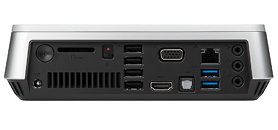Wednesday, September 11th 2013

ASUS Introduces the VivoPC Mini PC
MeMo Pad maker ASUS has today launched the VivoPC, a mini PC that measures 190 x 190 x 56.2 mm and weighs just 1.2 kg. Set to hit scores at the end of this month, the VivoPC will arrive in two main versions, one with a silver chassis and lower specs (VM40B) and one with a black casing and better hardware (VC60).
The VM40B packs a 1.5 GHz Celeron 1007U processor and 2 GB of RAM while the VC60 comes equipped with either a 2.4 GHz Core i3-3110M or a 3.1 GHz Core i5-3210M CPU and 4 GB of memory. Both models include a 500 GB hard drive, Gigabit Ethernet, 802.11 b/g/n/ac WiFi, Bluetooth 4.0, a 2-in-1 card reader, USB 2.0 and USB 3.0 connectivity, and a 65 W power supply.
The VivoPC VM40B is set to cost 229 Euro. The VivoPC VC60 starts at 349 Euro and will go up to 519 Euro.
The VM40B packs a 1.5 GHz Celeron 1007U processor and 2 GB of RAM while the VC60 comes equipped with either a 2.4 GHz Core i3-3110M or a 3.1 GHz Core i5-3210M CPU and 4 GB of memory. Both models include a 500 GB hard drive, Gigabit Ethernet, 802.11 b/g/n/ac WiFi, Bluetooth 4.0, a 2-in-1 card reader, USB 2.0 and USB 3.0 connectivity, and a 65 W power supply.
The VivoPC VM40B is set to cost 229 Euro. The VivoPC VC60 starts at 349 Euro and will go up to 519 Euro.




8 Comments on ASUS Introduces the VivoPC Mini PC